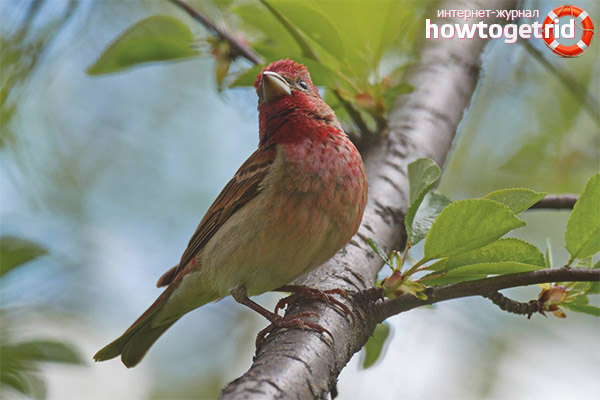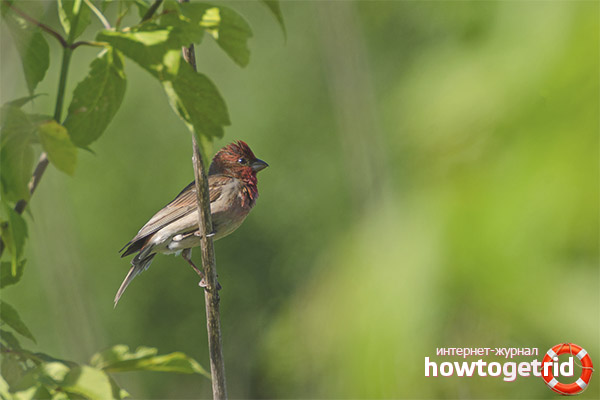The content of the article
On earth, there are a huge number of birds of various species. They differ in everything: size, behavior, manners, lifestyle. Many live in places that seem to be completely unsuitable for existence - take the same penguins. But it will not be about them, but about a little brisk lentil.
Description
At the word lentils, imagination immediately draws a cereal plant with flat kernels, like a bean. Few people know that this word is a migratory bird, very similar to a sparrow. Her name is the red sparrow.
In total there are 4 subspecies of this bird, each of them have slight differences in appearance and color, but in general terms they are similar. In size, lentils completely repeat the parameters of a city chirping inhabitant - length - up to 20 cm, weight - 80 grams, wingspan - 9 centimeters.Only two differences - thick, slightly swollen yellow beak and bright pink screaming coloring of males, by which you can immediately determine the type of feathered. The plumage is almost completely red-pink color, especially in the chest and goiter. Only the bottom of the body is painted in pinkish-white color and the undertail with the axillary hollows are pristine white. On the lower back and lower neck, dark red feathers are decorated with a light border.
Females cannot boast such bright colors: their plumage is reddish-gray with brown tint, the abdomen is slightly brighter than the back, the lower part of the body is ocher, the wings are decorated with longitudinal light stripes.
Where dwells
Lentils prefer to be wet around and settle where there is an excess of moisture. Most of them choose floodplain meadows, where bushes grow abundantly, but can live on forest edges. Constantly seen in gardens and cemeteries. In the mountainous area settles on forest edges, in the mouths and floodplains of rivers, in meadows.
Nesting and breeding
Lentils mostly prefer a solitary lifestyle, live in pairs only during nesting. Something like a token-up occurs: the males climb as high as possible on the tree, demonstrate their outfit, choking up the topknot and blowing out feathers, sing loudly and for a long time, trying to outperform the opponent and show their exclusivity to the female. At times there are clashes between rivals, ending without damage to the enemy. In the end, the female, watching the view from the lower tier or the ground, makes her choice.
After mating, the female looks for a place to nest, and both partners build a house for the next season. As a rule, the place is a tree or some spreading bush. Moreover, the female can specifically choose a plant where other birds will not exactly nest - for example, in the thickets of nettle. The house is very low from the ground, often - swampy and fired.Last year’s twigs, blades of grass, stalks of cereals and other plants growing near it serve as building materials. The tray is made very carelessly (blades of grass and twigs stick out in all directions), it looks like a cup measuring 16-20 centimeters. The floor is laid out with one's own and others' fluff, feathers, pieces of wool, grass and roots.
The only clutch over the summer takes place in June (although in the southern, warmer regions this may occur in May). The female lays from 3 to 6 eggs with a blue-colored shell speckled with black dots 18-21 millimeters long. The female is engaged in incubating, while the male brings food, protects the nest and the girlfriend from unwelcome visitors and sings songs.
After 12-15 days, the chicks hatch, and the singing stops - all efforts are given to feed the children. And at first only the father is engaged in feeding - the mother is recuperating. Then she begins to take care of the offspring. Parents bring insects, stars and oats as food. Children are next to their parents for 15 days, then they stand on the wing and begin to live independently.
Nutrition

The main diet is plant food - pecking seeds are pecking, in early spring they nibble the buds of trees growing in the area, willow catkins, they eat grass seeds (umbrella plants, legumes, cane and reed), pebbles unripe oats. They like berries (bird cherries, juniper, honeysuckle, viburnum and hawthorn). Sometimes they catch caterpillars and small bugs. Food is extracted in the air, they do not sink to the ground.
Wintering
At the end of July - early August, the birds move to warmer regions - India, south and southeast Asia. Those living in the southern, warmer regions linger until mid-September. They fly away unnoticed. Compared with other birds, it arrives in their native lands rather late - in May.
Moult
Interesting
It is quite easy to find a lentil's nest - the male constantly entertains a girlfriend, singing titivitin. For the sounds resembling the word "lentils", birds, and called that name.And only during the period of tokaniyu and nesting you can find and hear these red birds. At other times they lead a silent and quiet lifestyle.
Lentils adore the bird cherry and irgu - behind them they often fly to parks, picking up trees to the last berry.
Video: Common lentils (Carpodacus erythrinus)












To send